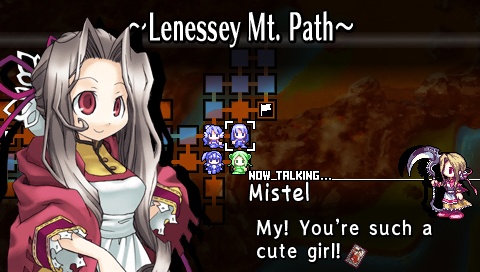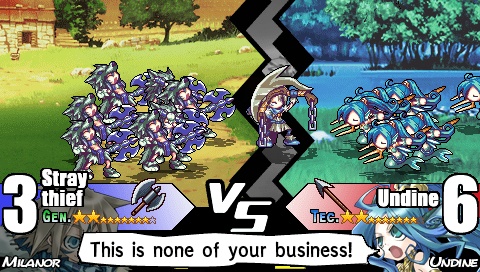Yggdra Union Hands-On
We join Yggdra in her fight to reclaim Fantasinia.
This strategy role-playing game about Princess Yggdra Yuril Artwaltz was originally released on the Game Boy Advance in 2006. There must have been something special about Yggdra besides the name because Atlus felt like it deserved a remake on the PlayStation Portable. It may not follow the usual structure of strategy RPGs because of its card-based system, but after spending some time and getting used to all the nuances, we found ourselves looking forward to fighting battle after battle. This version of Yggdra Union now has new missions, new playable characters, and difficulty options that give you another reason to spend some quality time with your PSP.
The game doesn't waste any time before diving into the action. We are introduced to Yggdra who has fled from her home and is the sole remaining survivor of the royal family. She quickly meets up with Milanor, an unusually friendly and helpful thief who joins her. Together they meet up with what's left of the royal army to fight against the Empire of Bronquia. While this budding relationship grows, we are presented with tutorials so that we aren't completely lost. The problem with many strategy RPGs is that there is a steep learning curve, which is discouraging to some players; however, with a little patience, Milanor does eventually get his point across. You may not be an expert at the ins and outs of the game by the end of the tutorial, but at least you'll have a general idea of what you need to do.

The bulk of the game involves fighting, but there will be dialogue during and between fights to move the story forward. It progresses on its own so there is no exploring; you're basically going from one fight to another. You collect cards as you go, with each card dictating your movement, power, weapon type, and special ability. Each turn is represented by the card you choose, and the movement is shared between the members of your team. You are given a top-down view of the battlefield and limited amount of spaces that you can occupy. This requires some thought as to how you plan out your attack because there are major bonuses if you can line up your characters before initiating an attack. For example, if you have a male leader (the person who is initiating the attack), anyone who is diagonally next to him will form a union so you're attacking as two or more units instead of one. If you're a female attacker, your union has to be horizontally or vertically next to you. Because you are only allowed to attack once per turn, getting your team lined up is crucial if you want to win.
Your card will also indicate if a weapon type is needed to start the battle. If it reads "all" then anyone can start, but if it shows an axe, then only the axe-wielder can lead the charge. This is important to note because there is a rock-paper-scissor setup with axes, lances, and swords. Axes are strong against lances, lances are strong against swords, and swords are strong against axes. Checking your enemy unit's weapon type before you move forward is wise and can save you from having to restart the mission over. Many of the missions include multiple battles before you can save again.
When you initiate a fight, the screen changes to a side view where you see multiple units hack and slash at each other until the other unit is wiped out. You have some control over this because you can use the D pad to adjust how aggressively or passively you want to play. However, if you don't want it to be interactive and are tired of watching the back and forth animation, the R button will fast-forward the fight. There are nine colored symbols on a scale that indicate which team has a greater chance of winning. This symbol will show up for both sides when the battle begins. Just because you have a symbol that is on the more "likely to win" side of the spectrum, this won't always guarantee the outcome.

Another quirk to Yggdra Union is instead of having conventional hit points, your hit points are represented by a morale pie chart. Once you've depleted the pie, your unit is considered lost and essentially dead. Your mission objectives will usually say that Yggdra can't die, so once her morale is gone, the game is over and you'll have to restart. You only get to attack once per turn, so you have to manually end your turn when the fight is over and use up whatever remaining movement is left.
The game features artwork done by manga artist Satoko Kiyuzuki. The anime characters are visually pleasing, with a lot of charm and fantastic detail. You'll notice the care taken when it comes to character outfits, and the animated sprites are also done well. However, it can take a while to get used to the presentation of the battles. The overhead map of the battlefield that you're usually fighting on is very simple, but once you zoom into the fight to see units slashing at each other, there is so much going on onscreen that it can be hard to keep track of everything. The game looks great on the PSP; though it just takes a while to figure out what is happening onscreen so that you don't feel overwhelmed and confused. The music is lively, but we haven't had a chance to listen to the entire score; we hope that there is a bit more variety than what we've listened to so far. Japanese voice acting is included if you want that option or you can turn off the voice acting entirely.
Yggdra Union is one of those games that players can become completely engrossed in as long as they are willing to put in the effort to figure out how it works to play effectively. Check back for our full review when Yggdra Union is released on September 16.
Got a news tip or want to contact us directly? Email news@gamespot.com
Join the conversation